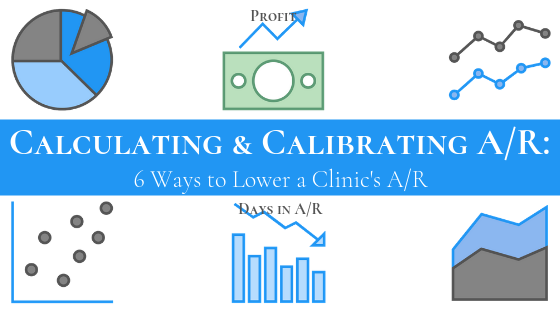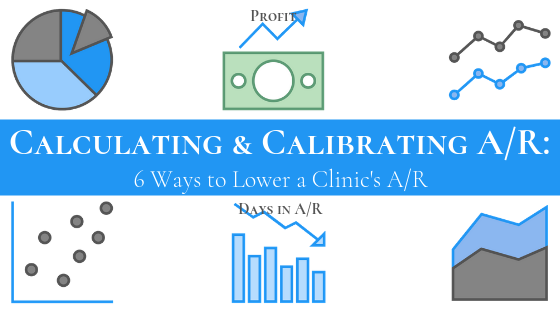Market trends demand medical clinics rethink patient billing and collections practices. An increasing number of insured Americans are covered by high deductible health plans that require greater out-of-pocket expenses. Use these six tools to help alleviate the pressures of collections.

One metric medical practices can use to help determine whether your revenue cycle management processes are effective is Days in Accounts Receivable (A/R), which refers to the average number of days it takes to collect payments due. The lower the number of days, the faster you are obtaining payment, on average. Days in A/R should stay below 50 days at a minimum, though 30 to 40 days is preferable.
How to Calculate Days in A/R
- Decide the period of time to use, such as six months or 12 months.
- Add all charges posted during that period.
- Subtract all credits received from the sum of the charges.
- Divide this by the total number of days in the selected period (e.g., 120 days or 365 days). This calculates your average daily charges.
- Calculate the days in A/R by dividing your total receivables by the average daily charges calculated in the previous step.
Once you know how long it takes to get paid for your services, you can take steps to shorten this time. You can also separate the balances by the individual payer or category of payers, such as commercial insurance, Medicare and patients. Below are several suggestions for steps your medical clinic can take to help lower the days in A/R for your patient receivables, both for uninsured self-pay patients and for the patient responsibility portions, such as co-pays.
Focus on the Patient Experience
People are more inclined to pay for service that is good and that meets their needs. A recent survey of hospital patients reported that patients are less likely to pay their medical bills if they experience negative billing interactions. Another recent survey found that 92 percent of healthcare consumers said improving customer experience should be a top priority for providers. Four technologies are especially desired in their healthcare experiences: digital scheduling, online payment options, patient portal and results reporting tools.
Run Electronic Eligibility
Run electronic eligibility checks of patients before their appointments to verify the patients' insurance coverage. Determine in advance what portion of the visit the patient's insurance will cover so you can better inform the patient about costs. Running electronic eligibility can alert staff to possible requests for treatment authorizations that might be necessary in order to receive payment from the insurance company. Eligibility checks also confirm the sources of payment to pursue after the visit.
Communicate and Educate Patients
Inform the patient ahead of time on the anticipated amount they will be responsible for so they can better budget for the expense and so they will not be surprised when expected to make a payment at the time of care. You likely will need to also educate the patient about the basis for this amount. According to a recent healthcare payments survey and report, patients are confused both by their explanation of benefits (72 percent surveyed) and by medical bills (70 percent). In this same survey, 65 percent of the patients indicated they would consider switching providers if they could get a better experience with payments.
Be Transparent About Pricing
Be upfront about your practice's fees, and do not have any hidden or surprise charges. Price transparency increasingly matters to patient consumers, as they bear a greater burden of their healthcare costs and thus are more price-conscious when seeking healthcare services. One study of patients and providers revealed that online patient payment estimations, plan administration and on-demand instructions were among the top improvements providers could make to increase patient satisfaction; these items also improve price transparency.
Provide Multiple Payment Options
Multiple options for how patients can submit payment increases the likelihood payments will be made. In addition to taking cash payments in person and accepting checks, your practice should consider allowing the use of credit or debit cards. The ability to make online payments, especially when through a patient portal, is desirable. One survey found that in the first half 2017, 95 percent of polled consumers would pay online if the providers offered that option. Eighty-seven percent of those surveyed want more convenient payment mechanisms. Payment by text messaging is offered by some practices.
Offer Payment Plans
Create payment plans for patients who cannot afford to pay the full balance at one time. Some practices with especially costly procedures, such as surgery centers, connect interested patients to a third-party vendor that provides a secured loan for the services. Your practice probably does not require such advanced financing options, but payment plans and incentives benefit practices' collection efforts. Allowing patients the flexibility to pay affordable installments over time means patients get the care they need and you get the cash you earned. Incentives such as prompt pay discounts that significantly discount the charges if payment is made the day of service or within a specified time-frame.
Market trends demand medical clinics rethink patient billing and collections practices. An increasing number of insured Americans are covered by high deductible health plans that require greater out-of-pocket expenses. From 2012 to 2017, the patient balance after insurance rose by 12.2 percent. These changes impact practices' collection balances and methods of collecting from patients.
Have any other ideas on to lower days in A/R? Let us know in the comment section below.



